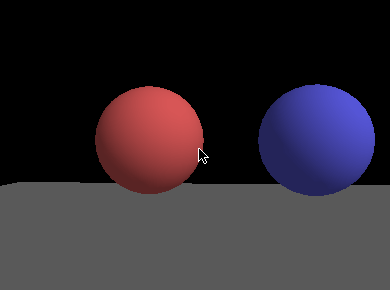如何在PyOpenGL上创建一个可以对鼠标移动进行“透视旋转”的摄像机?
我正在创建第一人称视角的RPG,并且我想在移动鼠标时在PyOpenGL中旋转相机(就像Minecraft等其他游戏一样)。我可以使用什么功能来执行此操作?
我尝试使用gluLookAt(),但是尽管经历了不同的尝试,但我不知道它是如何工作的。我什至不知道是否能帮上忙。
import sys,pygame
from OpenGL.GL import *
from OpenGL.GLU import *
cmddown = False
#...
keypress = pygame.key.get_pressed()#Move using WASD
if keypress[pygame.K_w]:
glTranslatef(0,0,0.1)
if keypress[pygame.K_s]:
glTranslatef(0,0,-0.1)
if keypress[pygame.K_d]:
glTranslatef(-0.1,0,0)
if keypress[pygame.K_a]:
glTranslatef(0.1,0,0)
mouse_movement = pygame.mouse.get_rel()#Get mouse event
#This is where the "look around" should be happen
pygame.display.flip()
1 个答案:
答案 0 :(得分:1)
您可以使用glRotate绕轴旋转一定量,该量由相对鼠标移动(pygame.mouse.get_rel())给出:
mouseMove = pygame.mouse.get_rel()
glRotatef(mouseMove[0]*0.1, 0.0, 1.0, 0.0)
但是那不会令您满意,因为如果鼠标离开窗口,该解决方案就可以继续工作了。
您必须在每一帧中将鼠标置于屏幕中间的pygame.mouse.set_pos()处。通过pygame.MOUSEMOTION事件获取小动作。例如:
# init mouse movement and center mouse on screen
displayCenter = [scree.get_size()[i] // 2 for i in range(2)]
mouseMove = [0, 0]
pygame.mouse.set_pos(displayCenter)
paused = False
run = True
while run:
for event in pygame.event.get():
if event.type == pygame.QUIT:
run = False
if event.type == pygame.KEYDOWN:
if event.key == pygame.K_ESCAPE or event.key == pygame.K_RETURN:
run = False
if event.key == pygame.K_PAUSE or event.key == pygame.K_p:
paused = not paused
pygame.mouse.set_pos(displayCenter)
if event.type == pygame.MOUSEMOTION:
mouseMove = [event.pos[i] - displayCenter[i] for i in range(2)]
if not paused:
pygame.mouse.set_pos(displayCenter)
不是,glRotate和glTranslate之类的操作会设置一个矩阵,并将当前矩阵乘以新矩阵。
currentMatrix = currentMatrix * newMatrix
这对于模型动画和变换是完美的,但是对于第一人称移动来说,这是错误的方式,在这种情况下,必须更改相机的位置和指向。
viewMatrix = viewTransformMatrix * viewMatrix
要做类似glGetFloatv(GL_MODELVIEW_MATRIX)和glMultMatrixf的操作。
在主循环之前,通过gluLookAt初始化视图矩阵,并通过viewMatrix将视图矩阵加载到变量(glGetFloatv(GL_MODELVIEW_MATRIX))中。
在每个帧的主循环中:
- 加载Identity matrix(
glLoadIdentity) - 对视图(
glRotatef,glTranslatef)进行新的转换 - 将当前视图矩阵乘以
viewMatrix(glMultMatrixf) - 为下一帧将新的视图矩阵加载到
viewMatrix
glMatrixMode(GL_MODELVIEW)
gluLookAt(0, -8, 0, 0, 0, 0, 0, 0, 1)
viewMatrix = glGetFloatv(GL_MODELVIEW_MATRIX)
glLoadIdentity()
# [...]
run = True
while run:
# [...]
# init the view matrix
glLoadIdentity()
# apply the movment
if keypress[pygame.K_w]:
glTranslatef(0,0,0.1)
if keypress[pygame.K_s]:
glTranslatef(0,0,-0.1)
if keypress[pygame.K_d]:
glTranslatef(-0.1,0,0)
if keypress[pygame.K_a]:
glTranslatef(0.1,0,0)
# apply the roation
glRotatef(mouseMove[0]*0.1, 0.0, 1.0, 0.0)
# multiply the current matrix by the get the new view matrix and store the final vie matrix
glMultMatrixf(viewMatrix)
viewMatrix = glGetFloatv(GL_MODELVIEW_MATRIX)
要进行上下查找,必须围绕x轴进行最终旋转。旋转的枢轴取决于角度。 必须将角度求和,并且必须在视图矩阵之后应用旋转,否则运动会根据角度改变(“高度”)水平。
viewMatrix = viewTransformMatrix * viewMatrix
finlalMatrix = lookUpDownMatrix * viewMatrix
要这样做,您必须合并上下旋转矩阵并将其乘以vieMatrix
up_down_angle = 0.0
run = True
while run:
# [...]
# init model view matrix
glLoadIdentity()
# apply the look up and down
up_down_angle += mouseMove[1]*0.1
glRotatef(up_down_angle, 1.0, 0.0, 0.0)
# init the view matrix
glPushMatrix()
glLoadIdentity()
# calculate new `viewMatrix`
# [...]
# apply view matrix
glPopMatrix()
glMultMatrixf(viewMatrix)
请参见下面的示例程序,以演示该过程。
请注意,程序将鼠标保留在窗口的中央,因此您无法再“移动”鼠标。
因此,可以通过 ESC 或 return 停止应用程序。
可以通过 pause 或 p 暂停该应用程序。当应用程序暂停时,鼠标不在窗口居中。
import pygame
from pygame.locals import *
from OpenGL.GL import *
from OpenGL.GLU import *
import math
pygame.init()
display = (400, 300)
scree = pygame.display.set_mode(display, DOUBLEBUF | OPENGL)
glEnable(GL_DEPTH_TEST)
glEnable(GL_LIGHTING)
glShadeModel(GL_SMOOTH)
glEnable(GL_COLOR_MATERIAL)
glColorMaterial(GL_FRONT_AND_BACK, GL_AMBIENT_AND_DIFFUSE)
glEnable(GL_LIGHT0)
glLightfv(GL_LIGHT0, GL_AMBIENT, [0.5, 0.5, 0.5, 1])
glLightfv(GL_LIGHT0, GL_DIFFUSE, [1.0, 1.0, 1.0, 1])
sphere = gluNewQuadric()
glMatrixMode(GL_PROJECTION)
gluPerspective(45, (display[0]/display[1]), 0.1, 50.0)
glMatrixMode(GL_MODELVIEW)
gluLookAt(0, -8, 0, 0, 0, 0, 0, 0, 1)
viewMatrix = glGetFloatv(GL_MODELVIEW_MATRIX)
glLoadIdentity()
# init mouse movement and center mouse on screen
displayCenter = [scree.get_size()[i] // 2 for i in range(2)]
mouseMove = [0, 0]
pygame.mouse.set_pos(displayCenter)
up_down_angle = 0.0
paused = False
run = True
while run:
for event in pygame.event.get():
if event.type == pygame.QUIT:
run = False
if event.type == pygame.KEYDOWN:
if event.key == pygame.K_ESCAPE or event.key == pygame.K_RETURN:
run = False
if event.key == pygame.K_PAUSE or event.key == pygame.K_p:
paused = not paused
pygame.mouse.set_pos(displayCenter)
if not paused:
if event.type == pygame.MOUSEMOTION:
mouseMove = [event.pos[i] - displayCenter[i] for i in range(2)]
pygame.mouse.set_pos(displayCenter)
if not paused:
# get keys
keypress = pygame.key.get_pressed()
#mouseMove = pygame.mouse.get_rel()
# init model view matrix
glLoadIdentity()
# apply the look up and down
up_down_angle += mouseMove[1]*0.1
glRotatef(up_down_angle, 1.0, 0.0, 0.0)
# init the view matrix
glPushMatrix()
glLoadIdentity()
# apply the movment
if keypress[pygame.K_w]:
glTranslatef(0,0,0.1)
if keypress[pygame.K_s]:
glTranslatef(0,0,-0.1)
if keypress[pygame.K_d]:
glTranslatef(-0.1,0,0)
if keypress[pygame.K_a]:
glTranslatef(0.1,0,0)
# apply the left and right rotation
glRotatef(mouseMove[0]*0.1, 0.0, 1.0, 0.0)
# multiply the current matrix by the get the new view matrix and store the final vie matrix
glMultMatrixf(viewMatrix)
viewMatrix = glGetFloatv(GL_MODELVIEW_MATRIX)
# apply view matrix
glPopMatrix()
glMultMatrixf(viewMatrix)
glLightfv(GL_LIGHT0, GL_POSITION, [1, -1, 1, 0])
glClear(GL_COLOR_BUFFER_BIT|GL_DEPTH_BUFFER_BIT)
glPushMatrix()
glColor4f(0.5, 0.5, 0.5, 1)
glBegin(GL_QUADS)
glVertex3f(-10, -10, -2)
glVertex3f(10, -10, -2)
glVertex3f(10, 10, -2)
glVertex3f(-10, 10, -2)
glEnd()
glTranslatef(-1.5, 0, 0)
glColor4f(0.5, 0.2, 0.2, 1)
gluSphere(sphere, 1.0, 32, 16)
glTranslatef(3, 0, 0)
glColor4f(0.2, 0.2, 0.5, 1)
gluSphere(sphere, 1.0, 32, 16)
glPopMatrix()
pygame.display.flip()
pygame.time.wait(10)
pygame.quit()
- 我写了这段代码,但我无法理解我的错误
- 我无法从一个代码实例的列表中删除 None 值,但我可以在另一个实例中。为什么它适用于一个细分市场而不适用于另一个细分市场?
- 是否有可能使 loadstring 不可能等于打印?卢阿
- java中的random.expovariate()
- Appscript 通过会议在 Google 日历中发送电子邮件和创建活动
- 为什么我的 Onclick 箭头功能在 React 中不起作用?
- 在此代码中是否有使用“this”的替代方法?
- 在 SQL Server 和 PostgreSQL 上查询,我如何从第一个表获得第二个表的可视化
- 每千个数字得到
- 更新了城市边界 KML 文件的来源?
